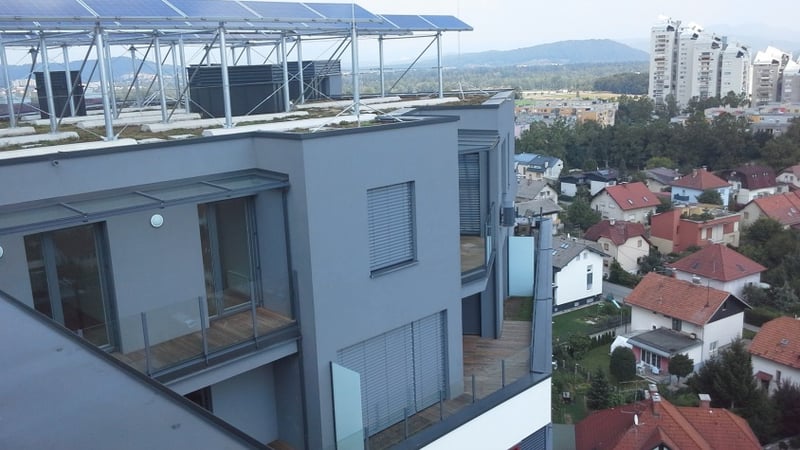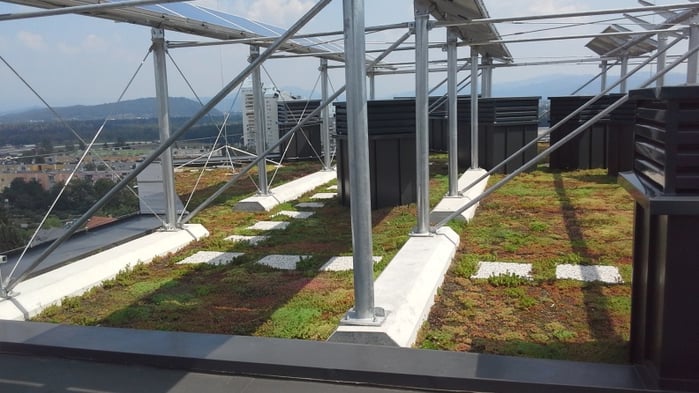Roofs can be seen in so many more ways than just the top of a building – as a complex structure accommodating a roof with solar panels, wind turbines and other equipment, as well as a green roof, which has many ecological benefits and can in some cases even be seen as a leisure area.
Green roofs have a proven track record of providing many benefits, such as improved air quality, effective temperature regulation and energy conservation, protection of the building envelope, improved longevity of roofing membranes, and various economic and ecological benefits, as well as providing an attractive, aesthetically-pleasing environment.

Green roofs and photovoltaic panels are complementary technologies that improve each other’s performance.
The conversion efficiency of photovoltaic (PV) panels is closely related to the operating temperature of the panel. PV efficiency decreases as temperatures increase, and cells exhibit long-term degradation if the temperature exceeds certain limits. High operating temperatures lead to lower conversion efficiencies.
PVs on green roofs function more efficiently with the cooler ambient temperatures present above green roofs; similarly, green roofs also benefit from the shaded areas that are created, which can be seen as better plant growth, increased biomass, and in some cases also an increase in the number of plant species and biodiversity.

Green roofs not only save energy during the summer, but can also increase the efficiency of PVs by reducing temperature fluctuations on the roof and by maintaining a more efficient microclimate around the PV panels. The green roof serves as a natural cooling mechanism, thereby serving to maintain panel efficiency.
Selecting appropriate vegetation type for PV green roofs
When selecting the appropriate plant species for PV-green roof systems, a number of criteria should be taken into account, including the suitability of plant species for extensive green roofs, resistance to extreme weather conditions, plant/PV and plant/building interaction, albedo, evapotranspiration, and low and compact plant canopies. As a result, plant species such as succulent, low-growing plants with dense foliage can be considered appropriate for these specific roofing systems, with the additional advantage that these plants could positively contribute to roof thermal inertia (Chemisana, Lamnatou, 2014). Sedum plants were compared with Ganzania plants (both drought-tolerant species suited for green roofs, with dense, low-height foliage and light-coloured leaves).

PV-green roofs proved to be more beneficial than conventional gravel roofs for both the PV module and the temperature of the roof surface. Certain characteristics of the plants lead to improved PV output, and the modules protect the plants from high irradiance rates/levels. This combination can also help reduce overall building energy consumption.
Performance of PV green roofs
How much performance can be improved by combining green roof design with photovoltaics is analysed using various approaches by various authors, as seen in the following:
a) Based on observations over a 5-year period (Köhler et al., 2007), green roofs in Germany boosted the energy output of panels by an estimated 6%. The experiment was conducted by comparing the PV–green roofs (planted with Sedum) and PV–bitumen roofs in Berlin.
b) Local temperature of green roof could enhance the performance of PV. Krauter et al. (1999) found that an increase in local temperature results in a lower conversion efficiency of 0.4–0.5% per ◦C for mono and multicrystalline photovoltaic panels. Similar results were obtained in a more recent study by Park et al (2008), where they observed a reduction of 0.48-0.52 % per ◦C.
c) Green roofs with lower air temperatures even boost the efficiency of PV panels in hot summer months, where an increase in temperature of just 1°C leads to a 0.5% reduction in power output. Temperatures on gravel roofs can easily exceed 50°C (-> uncovered roofs surface >70°C) on hot summer days, whereas temperatures on green roofs are typically below 35°C. In this context the synergy benefits of the green roof / solar power combination are particularly noteworthy (Appl and Ansel, 2004).
d) Intensive versus extensive light-weight green roof, combined with PVs, can also be compared. Extensive configurations seem to be more appropriate for PV-green applications. Intensive green roofs are less appropriate due to factors such as the (high) height of the soil / plant layer, the considerable weight of the whole system (Getter and Rowe, 2006), and issues related to aesthetic / building integration considerations.
e) Instant green roofs versus non-instant green roofs with plugs/seeds: with non-instant green roofs the bare soil can be exposed for a long period of time, from the installation phase through the full coverage phase, which can last several seasons. This is undesirable owing to the low reflectivity of bare soil. Therefore it is important for PV-green roofs to maintain almost total plant coverage in order to achieve high reflectivity and provide greater benefit for the PV modules. In general, green roofs have high albedo values and demonstrate several advantages compared to conventional technologies (Getter and Rowe, 2006).
f) When comparing PV and PV green roof systems in Hong Kong, Hui and Chan (2011) claim that PV systems using an integrated approach generate 8.3% more power than the stand-alone option.
Advantages of a PV-green roof

Advantages of a PV-green roof compared with simple, standard green roofing systems include (Lamnatou, Chemisana, 2014):
1. In situ production of electricity by means of a renewable energy technology / covering part or all of the energy needs of the building (the electricity generated by the PV panels could be also used to power the water pumps used for plant irrigation).
2. Plant growth and development is improved and the variety and richness of plant species are enhanced because PV modules protect plants from direct exposure to sunlight.
3. During winter, plants (due to their thermal capacity) protect PVs from the cold.
4. The positive synergy between plants and PVs leads to increased PV power output, depending on various factors such as plant type, climatic conditions, etc.
5. Building with a PV-green roof means lower cooling costs and related energy consumption,
6. Higher power production from PV-green roofs helps offset the cost of the green roof,
7. Better utilization of the available space of the roof.
Source of the photos: Urbanscape green roof with solar panels on the top of a multi-residence passive building in Ljubljana (Slovenia)
The efficiency of green roofs varies from one rainfall to another, and is dependent on climatic conditions and the specific design of the roof. If you would like to understand the real performance you can expect from your green roof, download one of our Sample Performance Evaluation Reports or ask for a customized report, specific to your needs or a project below:
Learn more about green roof system design and green roof benefits and visit our website or download our brochure here.
Literature cited:
- Appl, R. and W. Ansel. 2004. Future oriented and sustainable green roofs in Germany. In: Proceedings from the 2nd annual Greening Rooftops for Sustainable Communities conference, awards and trade show. Portland. OR. Green Roofs for Healthy Cities.
- Chemisana, D, Lamnatou, C., 2014. Photovoltaic green roofs: An experimental evaluation of system performance. Applied Energy 119 (2014): 246–256.
- Getter, K.L., Rowe, D.B., 2006. The role of extensive green roofs in sustainable development. HortScience 41, 1276-1285.
- Hui SCM, Chan SC. Integration of green roof and solar photovoltaic systems. In: Joint symposium 2011: integrated building design in the New Era of Sustainability. Hong Kong; November 22, 2011.
- Köhler, M., et al., 2007: Interaction between systems and extensive green roofs. Greening roofs to sustainable communities. Minneapolis; April 29–May 1, 2007.
- Krauter S., et al: Combined photovoltaic and solar thermal system for facade integration and building insulation. Solar Energy 67 (4–6) (1999) 239–248.
- Lamnatou, Chemisana, 2014. Photovoltaic-green roofs: a life cycle assessment approach with emphasis on warm months of Mediterranean climate. Journal of Cleaner Production 72 (2014) 57-75.
- Park, K.E. et al., (2008) “Analysis of thermal and electrical performance of semi-transparent photovoltaic (PV) module”, Energy, vol. 35, pg. 2681-2687



